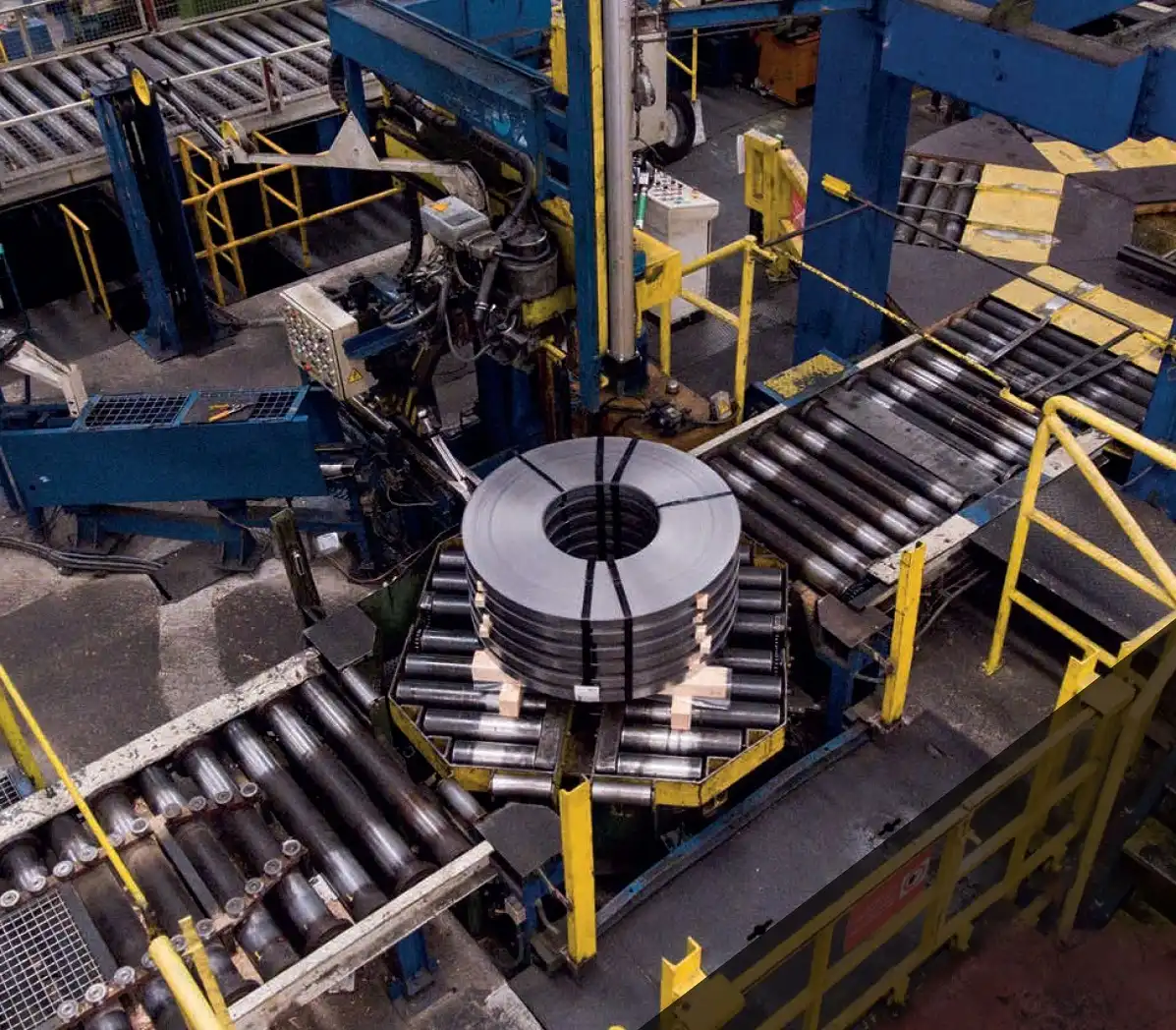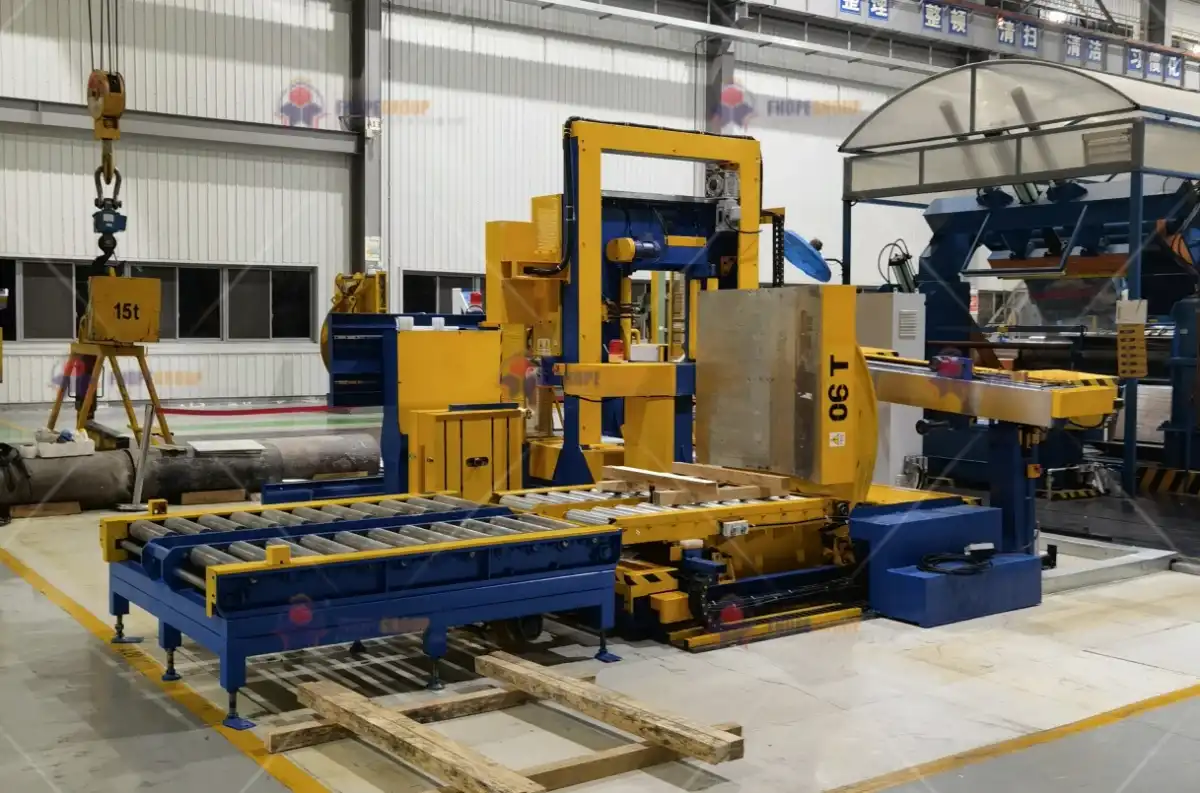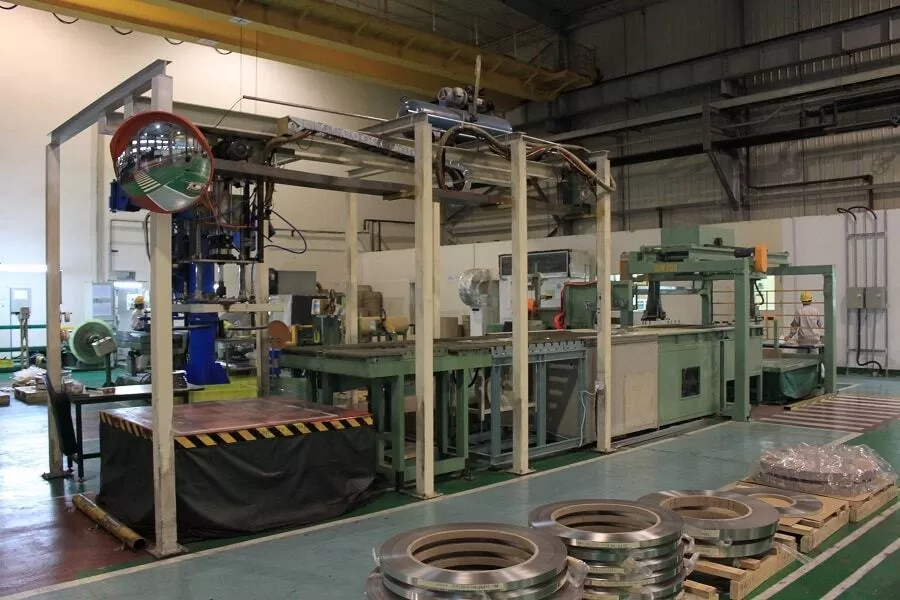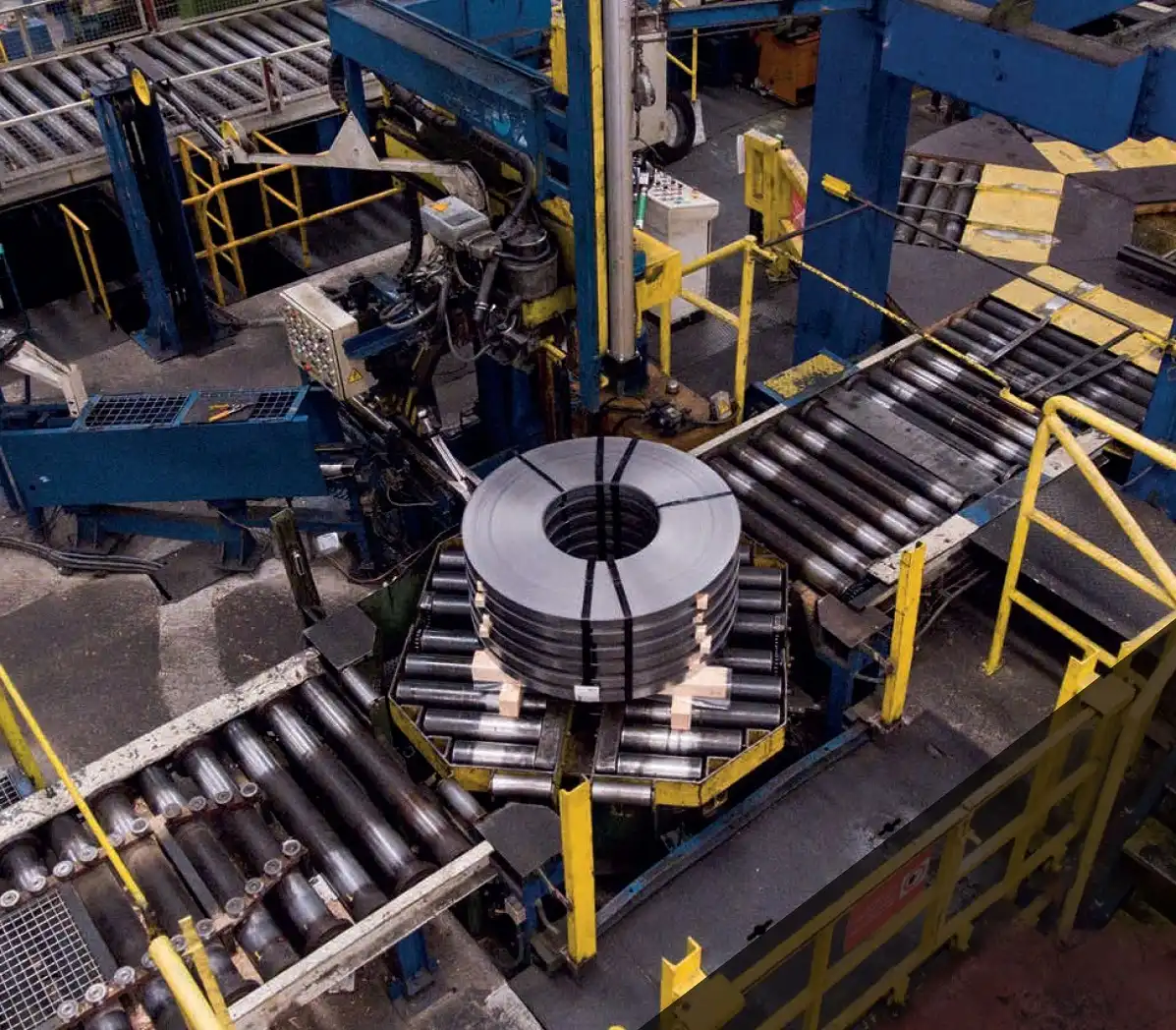Many steel mill owners I speak with, especially those spearheading ambitious projects in Saudi Arabia, face a common dilemma. They have aggressive growth targets driven by massive national initiatives, but market demand can be unpredictable. This creates a significant challenge when investing in critical infrastructure like a packing line. Do you invest in a huge, expensive line that might be underutilized for years? Or do you opt for a smaller system that could quickly become a production bottleneck, requiring a complete, costly, and disruptive replacement just a few years down the road? Both paths are fraught with financial risk and can hinder your ability to adapt.
This is where I've seen clients get stuck, feeling like they have to make a compromise between their present needs and their future ambitions. But there's a solution that eliminates this compromise entirely. A modular steel coil packing line offers a strategic approach. It allows you to build a system perfectly sized for your current output while giving you a clear, simple path to scale up operations as your project grows and the market demands it.
A modular steel coil packing line ensures scalability for large-scale Saudi projects because it is constructed from independent, interconnectable units. This fundamental design allows a steel mill to begin with a core packing setup that meets immediate needs. Then, as production capacity or product specifications change, new modules—such as additional strapping stations, advanced wrapping machines, or automated stacking systems—can be easily integrated. This eliminates the need to replace the entire line, providing a cost-effective and non-disruptive path to growth.

Thinking about your packing line as a collection of adaptable modules rather than a single, fixed piece of machinery is a significant shift. It's a move from a static investment to a dynamic asset. This approach is not just about adding capacity; it's about building resilience and flexibility directly into your operations. It’s a strategy I’ve personally championed after seeing the limitations of older, monolithic systems. Let's explore how this modular philosophy works in practice and why it's a perfect fit for the unique demands of projects in Saudi Arabia.
What Exactly Makes a Packing Line 'Modular'?
You're a practical leader. You hear a term like "modular," and you immediately want to know what it really means for your factory floor. Is it just a marketing buzzword, or does it represent a tangible engineering difference? The concern is valid. Many suppliers might use the term loosely, but a truly modular system is built on a specific design philosophy. It's a system where each major function is a self-contained unit that can operate independently but is designed to connect seamlessly with others.
Imagine trying to upgrade the engine in a car where every part is welded together. It's almost impossible. Now, imagine a car where the engine, transmission, and electronics are all designed as separate "blocks" with standardized connections. Upgrading one part becomes a straightforward process. This is the core principle of modularity in a packing line. It’s not just about breaking a line into pieces; it’s about designing those pieces to work together in any number of configurations.
A packing line is truly 'modular' when its core functions—such as conveying, strapping, wrapping, and stacking—are built as separate, standardized units or 'modules'. These modules can be added, removed, or upgraded independently without re-engineering the entire system. They share common mechanical footprints, electrical connections, and software communication protocols, allowing them to be plugged together like building blocks to create a customized and scalable production line.

Deconstructing the Modular Line
To understand this better, let's break down the components of a typical steel coil packing line and compare how a modular approach differs from a traditional, monolithic one. A monolithic line is often custom-built as one integrated piece of machinery. It's powerful for the specific task it was designed for, but incredibly rigid. A modular line, on the other hand, is about creating a flexible ecosystem.
Here are the typical modules you'd find:
- Coil Entry Module: This can be a simple conveyor, a turnstile, or an upender that receives the coil from the C-hook.
- Strapping Module: This unit performs the circumferential or radial strapping. A modular design means you could start with one strapper and add a second one later to increase throughput.
- Wrapping Module: This is the orbital wrapper that applies stretch film or VCI paper. You might start with a standard wrapper and later add a more advanced one that applies a top sheet for better weather protection.
- Weighing and Labeling Module: An integrated scale and printer that captures data and applies a label. This module can be easily upgraded as your tracking and data requirements become more complex (e.g., adding RFID capabilities).
- Stacking and Exit Module: This unit can stack smaller coils or palletize them before they are moved to the warehouse. A modular approach lets you reconfigure this for different coil sizes or customer requirements.
The Engineering Difference: Monolithic vs. Modular
The real difference lies in the design and interface between these units. A modular system prioritizes standardization.
| Feature | Monolithic Line | Modular Line |
|---|---|---|
| Initial Design | Designed as a single, integrated system for a fixed peak capacity. | Designed as a collection of independent modules with standardized interfaces. |
| Installation | Complex, long installation. Requires extensive on-site fabrication. | Faster installation. Modules are pre-tested and "plug and play." |
| Upgrades | Extremely difficult and costly. Often requires a full line replacement. | Simple. Add or swap a new module with minimal downtime. |
| Maintenance | A failure in one section can stop the entire line. Access can be difficult. | Isolate the faulty module for maintenance. Other parts can be checked. |
| Flexibility | Low. Locked into one process flow and capacity. | High. Reconfigure the line for new products or add capacity easily. |
| Capital Expense | High upfront investment for projected future capacity. | Phased investment. Buy what you need now, add modules as revenue grows. |
From my experience as an engineer, the beauty of modularity is in the details you don't see—the standardized PLC communication protocols and the uniform mounting brackets. These small things are what give you, the owner, immense strategic freedom. It turns a conversation about "machine specs" into a conversation about "business agility."
How Does Modularity Directly Address the Challenges of Saudi Projects?
The scale of development in Saudi Arabia, driven by Vision 2030, is unlike anywhere else in the world. Mega-projects in construction, infrastructure, and manufacturing create enormous demand for steel. But this growth isn't always linear. It comes in phases. A project might require 500,000 tons of a specific steel grade this year, but 1.5 million tons of a different specification in two years. This creates huge uncertainty for steel producers.
This is a problem I've discussed with many clients in the region. How do you invest in processing capacity when the goalposts are constantly moving? A traditional, monolithic packing line forces you to make a bet on future demand. If you bet too big, your capital is tied up in idle equipment, hurting your ROI. If you bet too small, you can't meet contract demands, damaging your reputation and losing out on massive opportunities. This is precisely the kind of volatility that keeps a CEO up at night.
Modularity directly addresses the challenges of Saudi projects by aligning capital expenditure with phased project timelines and fluctuating market demands. Instead of a massive upfront investment, steel mills can deploy a foundational packing line for the initial phase. As new project phases begin or market demand surges, additional capacity or new capabilities can be added by simply integrating new modules. This transforms the packing line from a fixed cost into a flexible asset that scales with real-world demand, mitigating financial risk.

Aligning Investment with Phased Growth
Many Saudi mega-projects are planned in distinct phases over 5, 10, or even 15 years. A modular packing line mirrors this approach perfectly.
- Phase 1: Foundation. You might start with a basic line: an entry conveyor, one strapper, one wrapper, and an exit station. This setup is cost-effective, quick to install, and perfectly matched to your initial production targets. You meet your immediate obligations without overspending.
- Phase 2: Capacity Boost. Two years later, a new contract doubles your required output. Instead of a crisis, it's a simple upgrade. We can add a parallel strapping and wrapping module. The existing line continues to run while the new modules are installed alongside it. The changeover to the expanded line takes days, not months.
- Phase 3: New Specifications. A major client now requires weather-proof packaging and automated palletizing. You don't have to redesign anything. You simply add a top-sheet applicator module before the wrapper and an automated stacking module at the end of the line. Your existing investment is preserved and enhanced.
This phased approach turns your capital expenditure from a huge, risky lump sum into a series of smaller, manageable, and justifiable investments. Each new module is added because there is a clear business case and a revenue stream to support it. This resonates strongly with leaders like Javier, who conduct rigorous ROI analysis for every investment.
Responding to Market Volatility and Product Mix
The steel market is cyclical. Demand from automotive can be high one year, while construction is the main driver the next. These sectors require different coil sizes, weights, and packaging.
- Handling Diverse Products: A monolithic line is optimized for one type of coil. A modular line can be designed with parallel paths. For instance, you could have one path for large, heavy coils and another for smaller, slit coils, each with its own specialized strapping and handling modules. This allows you to serve multiple market segments from a single, integrated line.
- Managing Downturns: In a slower market, you don't need to run a massive, energy-hungry line at 30% capacity. With a modular system, you can idle specific modules or an entire parallel path. This directly addresses the challenge of high energy costs by ensuring you only consume power for the production you actually need. It helps lower your operational costs and protect your profit margins, a key goal for any steel mill owner.
This adaptability means you are no longer a victim of market swings. You have the physical ability on your factory floor to pivot and respond to opportunities, which is the definition of a resilient business.
Can a Modular Design Future-Proof Your Investment Against Market Changes?
As a factory owner, your equipment is one of your biggest assets. But it can also be your biggest liability. A machine bought today can become obsolete tomorrow. This is a major concern. New environmental regulations can demand different packaging materials. A competitor might gain an edge with a more efficient process. Customers might start requiring smart labels or new packaging formats you can't currently produce.
This is the fear of being "locked in." You spend millions on a new packing line, only to find in five years that it can't meet new market requirements. You're then faced with another massive capital outlay just to stay competitive. This risk is a significant barrier to investment and a constant source of stress. It forces you to try and predict the future, which is an impossible task.
Yes, a modular design is one of the most effective strategies to future-proof your packing line investment. Because the system is composed of independent units, it allows you to adapt to future changes without replacing the entire line. You can upgrade a single module to incorporate new technology, swap a unit to comply with new environmental regulations, or add a module to offer new packaging services to your customers. This protects your initial capital investment and extends the productive life of the asset for many years.

Fighting Technological Obsolescence
Technology in the industrial space is evolving faster than ever. The rise of Industry 4.0, IoT sensors, and data analytics presents huge opportunities for efficiency gains. But it also threatens to make older, "dumb" equipment obsolete.
- Incremental Digitalization: A key goal for modern steel mills is achieving full production visibility through a Manufacturing Execution System (MES). With a modular line, you don't have to do this all at once. You can start by upgrading your weighing and labeling module to an "intelligent" version that includes IoT sensors and communicates directly with your MES. Later, you can upgrade the strapper to a predictive maintenance model that alerts you before a failure occurs. This step-by-step approach to digitalization is far more manageable and cost-effective. It aligns with the goal of deploying MES, IoT, and data analytics in a controlled, phased manner.
- Adopting New Automation: Perhaps a new robotic stacking technology emerges that is 50% faster than your current system. With a monolithic line, you're stuck. With a modular line, you can replace just the exit module with the new robotic stacker. You gain the competitive advantage of the new technology while preserving the rest of your line. This is how you stay on the cutting edge without breaking the bank.
Adapting to New Regulations and Customer Demands
The world is not static. Governments will introduce new rules, and customers will change their requirements.
- Environmental Compliance: Imagine a new regulation in Saudi Arabia mandates the use of biodegradable stretch film, which requires different tension settings and application methods. A modular wrapper can be swapped out for a new one designed for this material. This is a small, targeted expense to ensure compliance, not a multi-million dollar overhaul. This directly addresses the challenge of increasing environmental pressure.
- Meeting Niche Customer Needs: A high-value customer in the automotive sector might require a special paper interleaf to be wrapped with the steel coil to prevent scratches. You can win this lucrative contract by simply adding a small, specialized interleaf dispenser module to your line. This agility allows you to say "yes" to more customers and capture higher-margin business.
In my years of designing these systems, I've seen that the most successful companies are the most adaptable. A modular packing line is not just a piece of equipment; it is a platform for adaptation. It ensures that the investment you make today will continue to serve you for 15, 20, or even 25 years, because it is designed to evolve with your business and the market.
My Insight: Why I Believe Modularity is More Than Just an Engineering Term?
When I first started my career as an engineer in a packing machine factory, I saw 'modular' as a technical term. It was about standardized parts, plug-in connections, and efficient assembly. We focused on the mechanics of it. But after I left that job and built my own factory, and after helping hundreds of clients grow their own businesses, my perspective changed completely. I began to see the real-world consequences of equipment decisions.
I remember clients who had invested heavily in massive, custom-built packing lines. They were engineering marvels, incredibly powerful and fast. But when the market shifted, or when a new technology came along, these marvels became anchors. They were too big, too rigid, and too expensive to change. Seeing their struggle taught me a powerful lesson. The best-designed machine isn't necessarily the biggest or fastest. The best-designed machine is the one that gives its owner the most freedom.
For me, 'modularity' is not just an engineering feature; it's a business philosophy. It's about shifting power and control back to you, the factory owner. It gives you the freedom to start small, the confidence to scale big, the agility to pivot when needed, and the security of knowing your investment is built for the future, not just for today. It turns a machine from a cost center into a strategic tool for growth.

Modularity as a Business Strategy
When I founded SHJLPACK, I made this philosophy a cornerstone of our designs. My mission isn't just to sell machines; it's to share the knowledge I've gained to help others succeed. And the most important piece of knowledge I can share is this: build your operations for agility. Here is how I see modularity directly enabling your core business goals, moving beyond the technical specs.
Tying Modularity to Your Core Goals
Let’s look at the goals of a forward-thinking leader like Javier and see how this philosophy provides direct answers:
- Goal: Lowering Operating Costs by 8%. A modular line is not one giant, power-hungry machine. It's a series of smaller ones. If demand for slit coils is low this week, you don't run that part of the line. This granular control over operations means you're not wasting electricity and consumables on idle processes. This is a direct path to reducing unit energy consumption and overall operational costs.
- Goal: Increasing Equipment Uptime to 95%. With a monolithic line, a breakdown in one small component can shut down everything. With a modular line, the problem is isolated. You can often bypass the broken module while it's being repaired. Furthermore, maintenance is simpler. You can stock spare parts for standardized modules, and technicians can become experts on specific units. This is the foundation for a predictive maintenance strategy, a key component in maximizing uptime.
- Goal: Future-Proofing Against Aging Equipment. The challenge of a 15-year-old line is that everything ages at once. With a modular system, you engage in a process of continuous renewal. In year 7, you might upgrade the wrapper. In year 12, you might install a new, smarter strapping head. You replace components, not the entire asset. Your line never truly becomes "old."
- Goal: Driving a Successful Digital Transformation. The idea of deploying a massive MES system across an entire old plant is daunting. A modular approach makes it manageable. You can "pilot" your digital strategy on one module. Install IoT sensors on the strapping unit first. Collect the data, prove the ROI, and then roll it out to the next module. It de-risks your digital journey and builds momentum for the change.
My journey from engineer to factory owner taught me that financial independence and business success come from smart, strategic decisions, not just brute force. A modular packing line is exactly that—a smart, strategic asset that empowers you to navigate the complexities of the steel industry with confidence and control.
Conclusion
A modular packing line is a strategic asset. It delivers the essential scalability and flexibility for success in the dynamic steel industry, especially for ambitious projects across Saudi Arabia.




